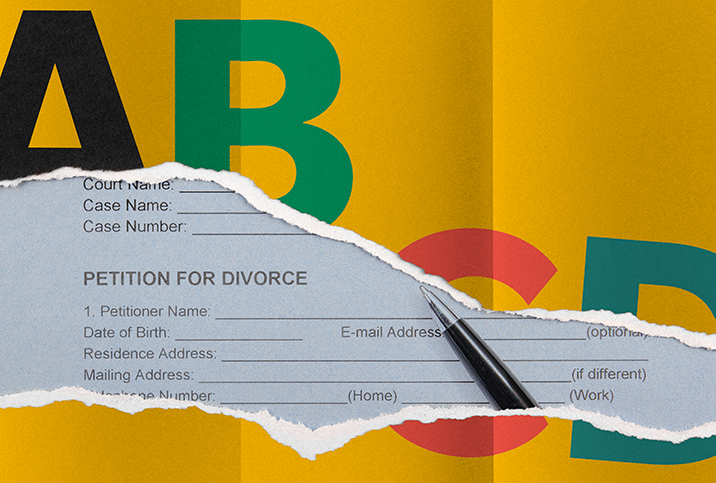How Marriage Rights Change from State to State in the U.S.

A globally acknowledged institution first recorded in 2350 B.C. in Mesopotamia, marriage is a binding contract that typically occurs between two individuals. Also known as matrimony or wedlock, marriage in the United States is an official as well as a cultural ritual, overseen and recognized by the government and/or religious entities. It is sealed by a ceremony called a wedding, which varies greatly by region, custom, ethnicity and religion.
Marriage is an agreement between two legally consenting adults. Generally, the age of consent in the U.S. is 18 years old, except for Nevada, where it’s 19. Exceptions are made for emancipated minors or minors whose parents or guardians sign consent. Marriages are void when a partner is under the state’s minimum age with parental consent, which varies by state and by gender. (With females at 12 and males at 14, Massachusetts has the lowest minimum age with parental consent.) This is then considered child marriage, which is illegal in the U.S. Also illegal: forced marriage and marriage to more than one person (polygamy).
Child marriage or any marriage based on an illegal act would be annulled, or voided, as if it never existed. However, while these are not federally recognized in the U.S., they may be sanctioned culturally in other countries, and tacitly approved by religious or cultural institutions.
Types of Marriage
Marriage is federally recognized between interfaith, interracial, and same-sex couples. Interracial marriage was legalized in 1967 when the case Loving vs. Virginia went before the Supreme Court. Same-sex marriage was legalized in 2015 when Obergefell vs. Hodges also was heard by the Supreme Court, which ruled that states could no longer prohibit it.
When only a government ceremony is performed, the union is known as civil. When a ceremony with religious or spiritual content occurs, matrimony is also a religiously approved one. In some countries, only religious marriages are recognized; in others, only civil ones are. In the U.S., religious ceremonies must include a civil component complying with the state jurisdiction where both parties live in order to be considered legally binding in the eyes of the government.
The End of Marriage
Marriage is legally ended by dissolution, which is a mediated termination where both parties agree to all details without the need for a court date, or divorce. A divorce is the severance of the marriage contract presided over by the judicial system and can be filed by one party but it cannot be finalized without the participation of both spouses in the separation of property and finances, as well as the agreement of custody and economic support in the case of minor children.
A dissolution, or divorce, is finalized when both the divorce certificate and the divorce decree are filed. The certificate is a notice meant for record-keeping purposes only. It does not contain all the details of the divorce and is not actionable but merely informative. The decree is a court-issued document that contains all the terms of financial and property separation as well as custody and support arrangements that have been agreed upon by lawyers or representatives of both parties. Should there be problems going forward, courts refer to the decree.
If a divorce certificate and a divorce decree are not filed or issued, spouses who have decided to pursue individual lives are considered legally separated but not divorced. A dissolution or divorce is final only when the decree is issued.
Marriage and Divorce Rates
According to the 2019 data pulled from the United States Census Bureau (USCB) which is the last year currently available, 2,231,263 women were newly married in the country. The national marriage rate for 2019 per 1,000 women over the age of 15 is 16.3 percent. By contrast, the national divorce rate for 2019 per 1,000 women over the age of 15 is 7.6 percent.
The USCB employs marriage data from women because, as they note, they are considered to be more reliable self-reporters. Data released from the 2020 census, including the American Community Survey (ACS) annual datasets that estimate statistics of marriages and divorces, will be staggered from September 23, 2021 to January 13, 2022. New information about marriages and divorce rates should be available between September 23 and October 14, 2021.
However, the Centers for Disease Control and Prevention (CDC) report slightly different numbers. For 2019, the CDC’s data puts new marriages in 2019 at 2,015,603 and divorces at 746,971. That puts the marriage rate at 6.1 percent per 1,000 and the divorce rate at 2.7 per 1,000. The discrepancy of data is due to limitations in state information collection and budgets for reporting marriage and divorce filings to the National Vital Statistics Report. For instance, in 2019, only 45 states and D.C. reported on divorce decrees.
Regardless, according to the USCB, during the decade of 2009 to 2019, both marriage and divorce rates fell. Marriages declined by 1.3 women per 1,000 over the age of 15. For the same population, divorces decreased by 2.1 women. For a state-by-state look at the decade’s decline, see this table.
Marriage Demographics
While marriage within one’s own faith is still more common than not, Pew Research Center reported in a 2015 survey that 39 percent of Americans who have married since 2010 have a spouse of a different religion. This appears to be a growing trend; of those married before 1960, only 19 percent had spouses of a different faith. However, Pew Research says that those numbers don’t account for divorces. And a Social Science Research study suggests that interfaith marriages are not as stable as same-faith marriages.
In 2015, 17 percent of newlywed couples were reported to be interracial. This number, 50 years after the federal legalization of interracial marriage, is a large jump from the three percent that reported themselves in an interracial marriage in 1967. Of those not newly or recently wed, one in ten were interracial.
Two years after the Obergefell case made LGBT marriage federally legal in 2015, a Gallup poll reported that “10.2 percent of lesbian, gay, bisexual or transgender (LGBT) adults in the U.S. are married to a same-sex spouse. That is up from 7.9 percent in the months prior to the Supreme Court decision in 2015, but only marginally higher than the 9.6 percent measured in the first year after the ruling.” However, at the time, more LGBT men (11.4 percent) were getting married than LGBT women (9.2 percent). Still, Gallup interpreted declining same-sex domestic partnership numbers to mean that 61 percent of same-sex partners were married at that time.
More adults are getting married for the first time as they near their 30s. According to Pew Research Center, who analyzed data from the USCB’s Historical Marital Status Tables, the median age in 2016 for women and men was 27.4 and 29.5, respectively. Compared historically to 1960, that’s a seven-year trend growth when women married at an average 20.3 for women and men at an average 22.8.
Socioeconomic status also plays a role. In 2015, 65 percent of adults 25 and older with a four-year degree were married. This is consistent historically. But the rates of married adults with a partial or no college education have been falling from more than 60 percent in both categories to now 55 and 50.
Benefits of Marriage
Marriage provides a framework for various conventions, benefits and obligations. One of the biggest benefits of marriage is that it provides an arena in which to engage in socially approved sexual relations. It also offers an accepted construct to enter into shared living arrangements with an emotionally supportive companion. Lastly, it gives a couple a sanctioned way to rear children.
People marry for many reasons aside from love, sex, friendship and emotional companionship. Not all of them are positive. Societal pressure, legal reasons, financial stability and religious or spiritual needs top the list. People also look for spouses to create a family, bear or adopt children, and gain extended family via “in-laws.” These interpersonal relationships are bonuses but also come with legal, ethical and moral obligations.
Financial stability is a driving factor in marriage. A 2019 study by Merrill Lynch indicated that 56 percent of Americans cite secure finances as a bigger factor than love when it comes to choosing a spouse. After all, as MarketWatch notes, buying homes and raising children both cost money. However, the same piece points out that spending that money is the opposite of insurance. A 2014 Emory University Department of Economics survey of 3,000 couples found that those who spent $20,000 or more on their wedding were 46 percent more likely than average to get divorced.
On the emotional front, married people tend to live longer, have fewer depressive episodes and turn to each for stress relief. This is, of course, in good marriages. Marriages where this kind of support is not the norm usually end in couples’ therapy, separation and/or divorce.
Risks of Marriage
Marriage has a history of restrictions. At one time, women were considered the property of men. The families of women were also expected to provide dowries, or money and gifts, to the men who married them. Until the 1970s, women’s roles in marriage were greatly constrained. Most did not work outside the home. Instead, they reared children and were largely engaged as homemakers while men earned the living.
Many spouses still go into marriage expecting certain gender roles to be followed. When they’re not, a break-up can ensure. Lack of communication is a chief complaint among the 39 percent of American couples who are divorcing.
Other risks of marriage include making bad financial decisions, ranging from signing prenuptial agreements to taking out joint credit cards, which can lead to permanent rifts. Fighting about money is, in fact, a top problem in many marriages, as is infidelity, lack of sexual or emotional approachability, ignoring one another’s boundaries and selfish behavior.
Perhaps the biggest risk in marriage is the possibility of domestic violence. Emotional, sexual or physical abuse occurs. The American Association for Marriage and Family Therapy estimates that almost 20 percent of marriages and intimate relationships involve assault.
Lastly, there is always the possibility that a spouse is fraudulent or has hidden motives, such as marrying for money, citizenship or some other type of gain.
The Effects of COVID-19
While divorce in 2019 was historically lower than it has been in 50 years, the pandemic and its accompanying recession are changing women’s roles in both marriage and the workforce. And one will likely continue to negatively affect the other. Patricia Cohen from the The New York Times wrote that married women with young children have a special burden of care. Because of the types of careers they choose, the closed daycares and schools, and the pressure of household chores and childcare, mothers are not recovering economically and are at the bottom of the workforce scale.
Some experts predict that these unique stressors, combined with those from lockdown and quarantine togetherness, may cause divorce rates to rise sharply in the coming year. But others don’t believe that. The Institute for Family Studies (IFS) American Family Survey data suggested that spouses have actually grown closer and that when statistics are out for 2020, we will see that divorce rates have continued to fall. “A majority of married Americans (58%) say that the pandemic has made them appreciate their spouse more and half agree that their commitment to marriage has deepened,” write the IFS researchers. “Moreover, initial data from some states suggests that divorce filings have indeed declined. It is likely that divorce may increase a bit after COVID-19 because of the pent-up demands, but the overall decline in divorce appears to be a consistent trend.”
Myths
You need to be married by 30
The median age for marriage right now is about 30, which is why people start to feel pressure as this birthday approaches. But compare it to the 1960s, when it was around 20. Obviously, things change. It doesn’t matter what society thinks. Settling for the wrong person because of some made-up deadline will always be a bad idea—and lead to divorce.
A baby will save my marriage
Having kids will not save a failing relationship, let alone a marriage. If anything, children add more stress—physically, emotionally, and financially.
We’ll have the same ideas and interests
Of course, you won’t. Two people do not meld into one after a ceremony. You go into a relationship a whole person, with individual opinions and tastes, and you remain that way.
We’ll become co-dependent
You may enjoy some hobbies and pastimes with your spouse that you didn’t before, simply in order to spend with them. And vice-versa. It’s great to develop some shared interests. But maintaining independence is not only encouraged but desirable.
We’ll never fight
You will. Marriage is a give-and-take. Sometimes it may take a little time to learn how to compromise. Sometimes you have to give to get.
We’ll always fight
You won’t, as long as you keep in mind that effective, respectful communication will prevent resentment, disinterest and criticism.
We’ll split everything equally
While it sounds good on paper, it doesn’t work that way in real life. Chores tend to fall to the one willing to do them, or to the one who has more natural ability in doing them. If you’re folding the laundry and your spouse is paying the bills, does it really matter in the long run as long as everything gets done?
Remarriage
For many, marriage and divorce aren’t singular, one-time events. Older Americans in particular have multiple marriages and/or divorces. But marriages that end don’t always culminate in divorce. Some conclude with the death of a spouse, which is tragic. But after time, it can lead to the discovery of a new partner.
For those 55 and older, remarriage is trending higher, according to Pew Research Center. For those younger, it’s lower. This makes sense, given that age comes with health complications. In 2013, 64 percent of men who have been widowed or divorced had remarried, and 52 percent of women had done the same.
For those younger than 35, though, the rate of remarriage has declined 30 percent since 1960. Where once young adults who had left first marriages were 72 percent eager to find new spouses, in 2013 they were only 42 percent willing to say those vows again.
Indeed, marriage in general as an American institution is in its greatest decline ever. Since 1972, rates have fallen by 50 percent. The good news, as marriage rates have declined, so have those for divorce. Those who are marrying are staying married longer, despite the challenges that it brings.


















